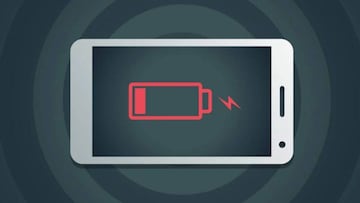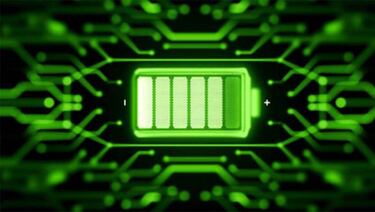10 things that kill your battery and shorten the life of your smartphone
From location services to screen brightness, we take a look at all those little settings and details that can extend the life of your smartphone.

When we change mobile and it is a new device, we do not have to charge the battery until the next day - or even two days. But after a while, we notice the same as always: the charge lasts just long enough to get through the day, or perhaps not even that, and we have to carry the power cable with us.
Why does the battery drain so much, if the use we make of it has not changed? Each smartphone is different, but we can tell you 10 things that tend to kill the smartphone's battery, which drain it more than usual and therefore shorten the life of this and the device itself.
Screen on standby
According to several studies, the average time we usually look at our smartphones is between 85 and 150 times a day. Sometimes it is simply to check the time, if we have no messages or notifications, and we put it back on the table. This is the same amount of times we turn on the screen. One of the options that we can configure in a smartphone is the time that it remains on standby before the screen dims and turns off. But if instead of having it programmed to turn off every minute or five minutes, we can reduce that frequency to between 10-20 seconds. The amount of time that the mobile will remain with the screen off will be longer, therefore it will consume less and we will have more battery time.
Maximum brightness and resolution
Smartphone displays are now reaching 2K or 4K and can output HDR content. They look amazing, and their brightness capacity is getting higher and higher. But it is precisely the part of the mobile that demands and consumes the most energy. And the higher you have the brightness, the less your battery is going to last. This can help extend battery life significantly, especially for devices with larger, sharper screens (i.e. more pixels). The only time you probably need your phone at 100% brightness is outdoors, at midday, when the sun is at its brightest.
At any other time, you can reduce your phone's brightness to 75% or less. You can adjust this in Android by going to Settings > Display or by swiping down from the notification bar. Newer phones also have an adaptive brightness setting, which allows the device to adjust automatically, and it's a good idea to have this enabled. This way, by not always being at maximum, it won't raise the temperature of the device as much either.
The resolution is another matter. If you have a high-end phone and you notice that the battery is not enough, try lowering the screen resolution. If you have it in WQHD+, try lowering it to FullHD+ or HD+. The lower the resolution, the less energy the screen needs and therefore the lower the consumption.
Bluetooth and GPS all the time
These are two elements that drain a cell phone battery. If you need to be constantly physically reachable, then the GPS will always be on. But if not, try turning it off and putting it on just to look something up on Google Maps, and you'll notice how the battery seems to last longer.
As for Bluetooth, if you use it in conjunction with a wearable such as a headset, watch, bracelet or in the car, keep it activated only when you use them. When you don't really need it, turn it off and thus help both the smartphone battery and the wearable battery itself.

Sync ON
Among those icons in the top sliding menu, you will see one that says Sync or Synchronize. It is very useful when the phone is connected to the Internet, because thanks to it the apps are synchronized and we receive notifications for example when we get an email in Google Mail (if we do not activate it we would have to go to the Gmail app and synchronize it manually). But Sync:
- A) It consumes a lot of battery
- B) When the mobile is offline it doesn't make much sense to have it activated. Even if you have to leave Data or Wifi on, removing it will slow down the power consumption a bit.
Farewell, Google Assistant
Let's face it, Google Assistant is a very useful tool, but it's also one of the Android features that constantly drains your phone's power. It's listening for your wake-up command, it's connected to your location for instant contextual results and much more. If you don't use it often, why have it enabled?
- Open the Google application
- Tap your profile picture and select Settings
- Go to Google Assistant > General and disable Google Assistant
You can also ask it to turn off using the command "Hey Google, turn off Google Assistant", then tap the Assistant settings and turn off Google Assistant from there.
Which apps have access to the location service?
Many applications use the smartphone's location service in the background, and this is an element that drains a lot of battery. One way to save is to take a look and see how many apps are using it. To do this go to Settings > Location > App permissions and look at the list. If you want some of them to have constant access, leave them, but most of them can be set to connect only when you are using them, or directly stop them from being connected if they are applications that do not need this service for their function.
Energy saving mode deactivated
It's great to have a phone that responds instantly to everything from opening your social media to playing games, watching videos, and scrolling the screen smoothly. But you can also do that while saving energy. If you activate the battery-saving mode, the phone will take a series of measures to do just that. Features like Always On display will be disabled, the CPU will limit its speed, the screen brightness will be dimmed and things like 5G will be switched off.
What will happen to your smartphone? Maybe it will take a little longer to open an app, you won't see the screen scrolling as if it were at 120Hz, etc. But if you do not need to have the mobile always running at maximum capacity, this will give you more autonomy and at the same time, it will make the terminal heat much less.
Apps with the highest battery consumption
Open Settings, go to the Battery section and go to Details / Usage or the section where the detail of energy consumption of the device appears. With it, you will see the apps that are consuming the most energy from your phone, and you may be surprised to see some that you don't even use or are supposed to be closed. If you do not want them to be draining so much, you can put them to sleep, so that they are running in the background occasionally, or in deep sleep mode so that they are only activated when you open them.
Roaming enabled
Like GPS, 4G and 5G can drain power, especially if you have poor cellular signal. If you're traveling to a remote or mountainous region and your battery life is more important than connectivity, you can temporarily disable data roaming. On Android, you can do this through Settings > Connections > Mobile Networks. A quicker solution is to enable Airplane Mode, although this blocks all services, including Wi-Fi.
Dark Mode disabled
Related stories
Blue light from screens has become a major issue, and dark mode has a lot to say about it. This type of light affects our body, making it harder for us to fall asleep. Activating the Dark mode in an app that you use a lot at night or in the whole device, will allow you to reduce the impact of bright light on your eyes in low light conditions.
The good thing about Dark Mode is that it is beneficial for the user and their device since in normal conditions, there are thousands of pixels on the mobile screen that are active. With the dark mode, several of these will be turned off or their brightness will be reduced, which will affect the battery of the mobile and allow us to extend it even more.